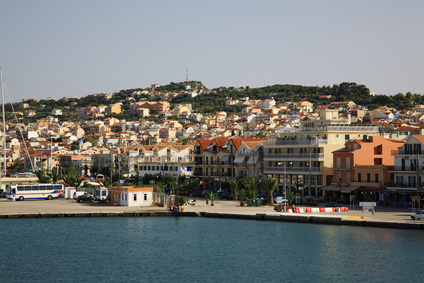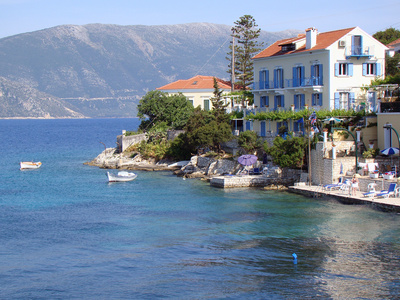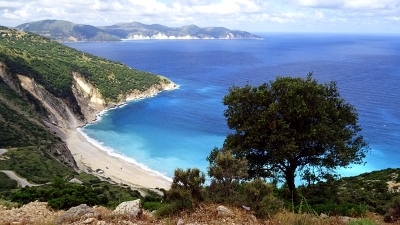Kefalonia (about 42,000 inhabitants) is the largest of the Ionian islands with 738 km² – even larger than the much more famous Corfu. The island is somewhat behind in the development of tourism. A holiday on Kefalonia is especially interesting for nature lovers and hikers. There are dense forests, steep and high mountains, lakes and wild rivers. The mountains are high: the peak of Ainos is 1,625 meters above sea level. Since the island is large, you can easily spend a whole holiday there.
The capital Argostoli
 Image: Deborah Benbrook – Fotolia.com
Image: Deborah Benbrook – Fotolia.com
The capital and port of Kefalonia was almost completely destroyed by an earthquake in 1953. After reconstruction, Argostoli now has a modern cityscape with not too much flair. It was not the first disaster in the capital’s recent history. The small town was also heavily bombed in World War II.
The main shopping street runs parallel to the shore about 100 meters away. The boulevard along the harbor is also worth a stroll. Some old buildings have been extensively rebuilt. Today, Argostoli is by far the largest town and the only town on the island of Kefalonia with around 12,000 inhabitants.
The town is, however, very suitable as a base, as most buses to Kefalonia leave from here. There are many nice taverns, private rooms and hotels (medium prices) in Argostoli.
Ferries rarely come to Argostoli anymore, as the crossing from the mainland to Sami on the opposite side of the Ionian island of Kefalonia is much closer. Public buses take ferry passengers from Sami to Kefalonia.
Tours from Zakynthos to Kefalonia
Zakynthos has a lot more tourists on holiday than Kefalonia. Many take a day trip by boat from Zakynthos to the neighboring island. A good day trip can easily be booked online: More information and booking
Where is Kefalonia most beautiful?
Kefalonia (also Kefallonia) is one of the most beautiful islands in Greece with diverse landscapes and stunning beaches. Here are some of the most beautiful places:
1.Myrtos Beach – One of the most famous beaches on the island, famous for its crystal clear turquoise waters and dramatic rocky landscape. It is a must for every visitor.
2.Assos – A picturesque, traditional village with charming houses, located on a small peninsula. The place offers stunning views and a small but beautiful beach.
3.Sami – A coastal village with great views of the Ionian Sea and the nearby Melissani Lake, an underground cave with crystal clear waters.
4.Fiskardo – A picturesque fishing village in the north of the island, known for its Venetian architecture and colorful houses. Here you can stroll along the marinas and enjoy the charm of the place.
5.Antisamos Beach – A beautiful sandy beach with crystal clear waters and surrounded by green hills. It has been used in films such as “Captain Corelli’s Mandolin”.
6.Skala – A beautiful and longer beach with fine sand and clear waters. Ideal for families and those who want to combine relaxation with good infrastructure.
Accommodation
The vast majority of hotels on Kefalonia are in the populated south of the island. In the capital Argostoli is the Ionian Plaza Hotel, one of the best accommodations on Kefalonia.
Other places on Kefalonia
Sami: Nature lovers in particular stay in the beautiful village of Sami in the east. The high mountains, Lake Melissani and the famous Drograti cave are within walking distance. The large cave (5 km from Sami) is particularly worth seeing. Sami is considered the largest ferry port on the island of Kefalonia.
Luxouri: The second largest city on the island is located opposite the bay in front of Argostoli. It is the prettier one: after the earthquake it was rebuilt as it was originally. A ferry connects the two large cities on Kefalonia every hour.
Fiskardo: The town in the north has experienced a boom in the last 1-2 decades. Real estate prices have increased many times over. Fiskardo is perhaps the most beautiful place on the island and is closed to cars.
 Near Fiskardo (north of Kefalonia)
Near Fiskardo (north of Kefalonia)
Image: Urbanus Eskiniwach – Fotolia.com
Bus on Kefalonia: There are buses from Argostoli to almost all villages on Kefalonia, but unfortunately the timetable is a bit sparse. Most lines only run 2-3 times a day. However, you can often get everywhere in the morning and take another bus back in the afternoon. The fares are cheap. Kefalonia is big: a single bus ride can take an hour or more.
Ferry to Kefalonia: There are several daily ferry connections from Argostoli to Killini (also on the Peloponnese peninsula). From there you can take the bus to Patras and Athens. In summer there are almost daily ferries from Fiskardo in the north of Kefalonia to the island of Lefkas and the nearby island of Ithaca. A small ferry connects the south of Kefalonia with the north of the island of Zakynthos. There are also ferries directly to Patras, the largest city on the Peloponnese. Due to the competition from various ferry companies, the prices are not high. Most ferry tickets cost less than 10 euros per person (as of 2015).
Map
|
Kefalonia lies between the island of Zakynthos in the south and the island of Lefkada in the north. It is only 2 kilometers from the small island of Ithaca. The distance to the mainland is at least 30 kilometers. It is about 100 km to the city of Patras. The city of Alexandroupolis on the Greek mainland is about 30 kilometers to the north. |
There are daily flights from Kefalonia to Athens. In summer there are charter flights to Kefalonia, for example from and to Austria and Great Britain. The airport is just 4 kilometers south of Kefalonia’s capital, Argostoli. Kefalonia’s airport, with the lovely name “Odysseus Airport,” can only be reached by taxi.
Special features of Kefalonia: The island is a breeding ground for the giant sea turtles Caretta Caretta. Kefalonia is also home to the rare and strictly protected monk seals. One of the top sights on Kefalonia is Lake Melissani. It is in a kind of underwater cave into which sunlight shines at certain times of the day (very spectacular play of colors). Kefalonia has a very special cuisine that is more reminiscent of Italian than Greek cuisine. Kefalonia has dense forests and large rivers. The sparsely populated island is ideal for a hiking holiday. There are at least 20 good beaches on the island.

Kefalonia is far less touristy than some other Ionian islands such as Zakynthos or the well-known island of Corfu. The island is still an insider tip. Kefalonia is often referred to as a wild island. The mountains, rivers, forests and beaches are an ideal holiday destination for all nature lovers who do not like mass tourism. Some monasteries and castles are also more than worth seeing.
What to do as a tourist on Kefalonia?
Discover beaches
Myrtos Beach: One of the most famous beaches in Greece with white pebbles and turquoise water.
Antisamos Beach: Perfect for swimming and water sports, surrounded by green hills.
Petani Beach: Similar to Myrtos, but less crowded.
Xi Beach: Known for its red sand and clay, which is used as natural spa mud.
Visit natural wonders
Melissani Cave: An impressive underground cave with a lake that can be explored by boat.
Drogarati Cave: A stalactite cave with amazing acoustics.
Ainos National Park: Hike up Kefalonia’s highest mountain and enjoy spectacular views.
Charming villages and towns
Fiskardo: A picturesque fishing village with colorful houses and cozy tavernas.
Assos: A charming village surrounded by a peninsula and a Venetian castle.
Argostoli: The capital, where you can stroll along the harbor promenade, watch Caretta-Caretta turtles and visit museums.
Experience culture and history
Agios Gerasimos Monastery: A spiritual center and the home of the island’s patron saint.
Fortress of St. George: A Venetian castle with great views and historical significance.
Argostoli Archaeological Museum: Exciting finds from ancient times.
Activities and adventures
Diving and snorkeling: Explore Kefalonia’s underwater world.
Boat tours: To hidden bays or neighboring islands such as Ithaca.
Wine tastings: The Robola wine produced on the island is particularly well-known.
Enjoying culinary delights
Try local specialties such as kreatopita (meat pie), bourbourelia (bean soup) or fresh fish in a traditional tavern.
Flora and fauna
Kefalonia is dominated by Mediterranean vegetation, with many plant species typical of the region.
1. Forests and trees
Kefalonian fir (Abies cephalonica): This rare fir species is endemic and grows mainly in the Ainos National Park. The Ainos is therefore also called “Black Mountain” because the firs darken the landscape.
Olive trees: The olive groves on Kefalonia are not only economically important, but also characteristic of the landscape.
Cypresses and pines: Typical of the island and found especially on the slopes and coastal regions.
2. Flowers and herbs
Wild orchids: Kefalonia is home to numerous species of orchids, especially in the spring months.
Aromatic herbs: Thyme, rosemary, sage and oregano grow wild and are important for local cuisine and bee production.
Colorful wildflowers: In spring, flowers such as poppies, chamomile and daisies cover the island.
3. Agricultural plants
Grapevines: Especially for the famous Robola wine.
Citrus fruits: Lemon and orange trees are common throughout the island.
Almond and fig trees: Other typical crops.
Fauna
1. Mammals
Wild goats and sheep: Commonly seen in the mountains and fields.
Foxes and hares: Are among the local wildlife.
Bats: Particularly found in caves such as Drogarati.
2. Birds
Birds of prey: Eagles, falcons and buzzards nest in the mountains.
Migratory birds: Kefalonia is on a migratory route, so many species of birds, including flamingos and herons, rest in the wetlands.
Blue rock thrushes and hoopoes: Typical bird species found in the island’s nature.
3. Marine animals
Caretta-caretta turtles: The loggerhead turtle nests on some of the island’s beaches, such as Mounda Beach.
Monk seal (Monachus monachus): A rare and protected species that lives in the waters around Kefalonia.
Fish and marine life: Kefalonia’s coasts are rich in fish species, octopuses, starfish and sea urchins – ideal for snorkeling and diving.
4. Insects
Butterflies: The island is home to many colorful species of butterflies, especially in spring.
Bees: Famous for the delicious honey produced from the aromatic herbs.
Special nature reserves
Ainos National Park: Protected area for the fir forests and wildlife.
Lagoons and wetlands: Like Lake Koutavos in Argostoli, which provides a habitat for many species of birds.
Do you have a specific question about an animal or plant on Kefalonia? Or are you planning to cover these aspects in your travel guide?
Our travel guide about Croatia
Do you have feedback, an addition, found an error or a comment? Send us an email to: mail@griechenland-insel.de